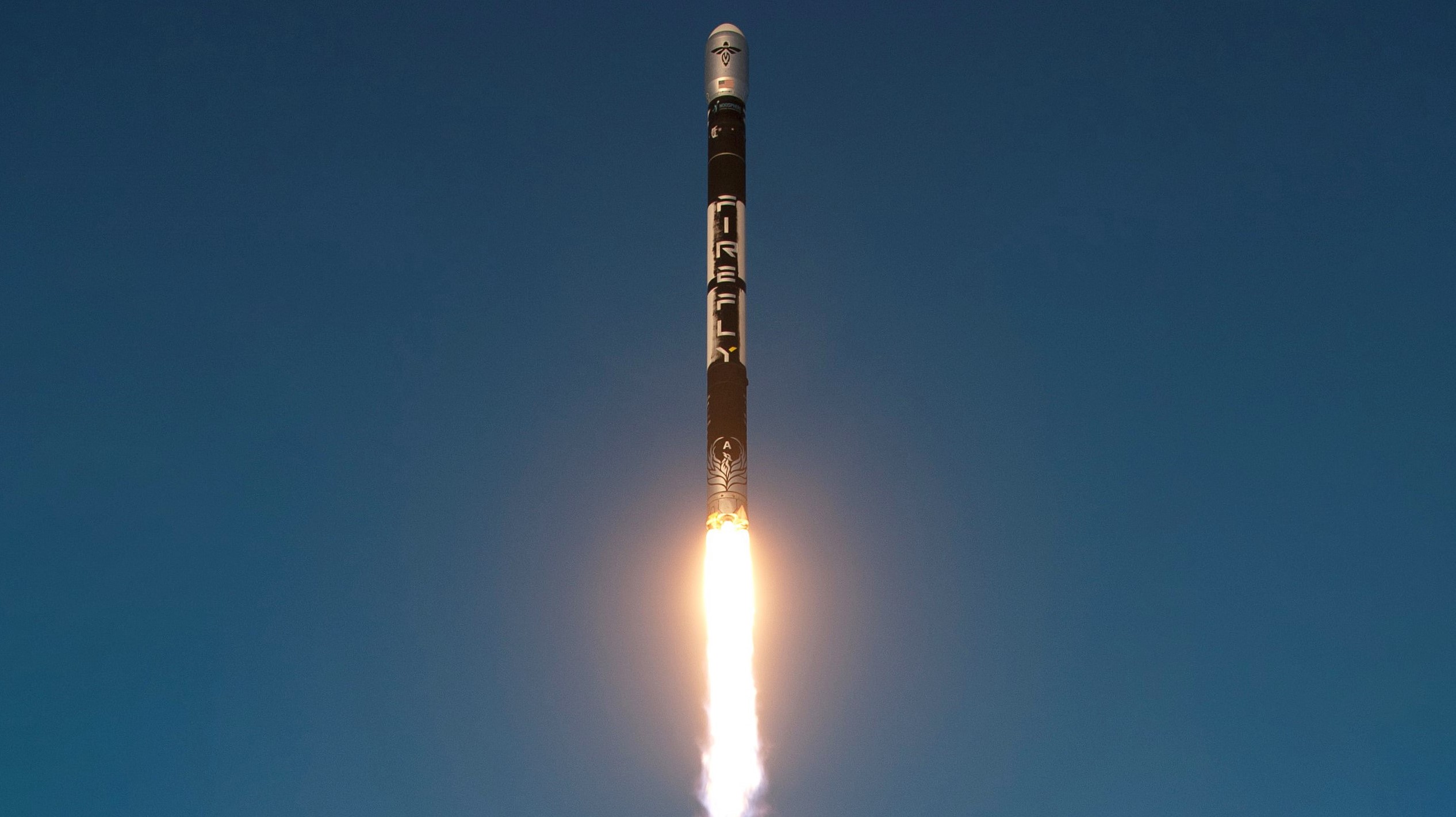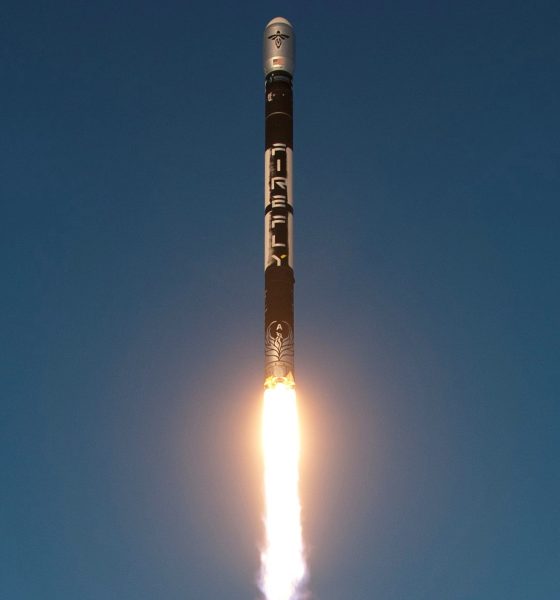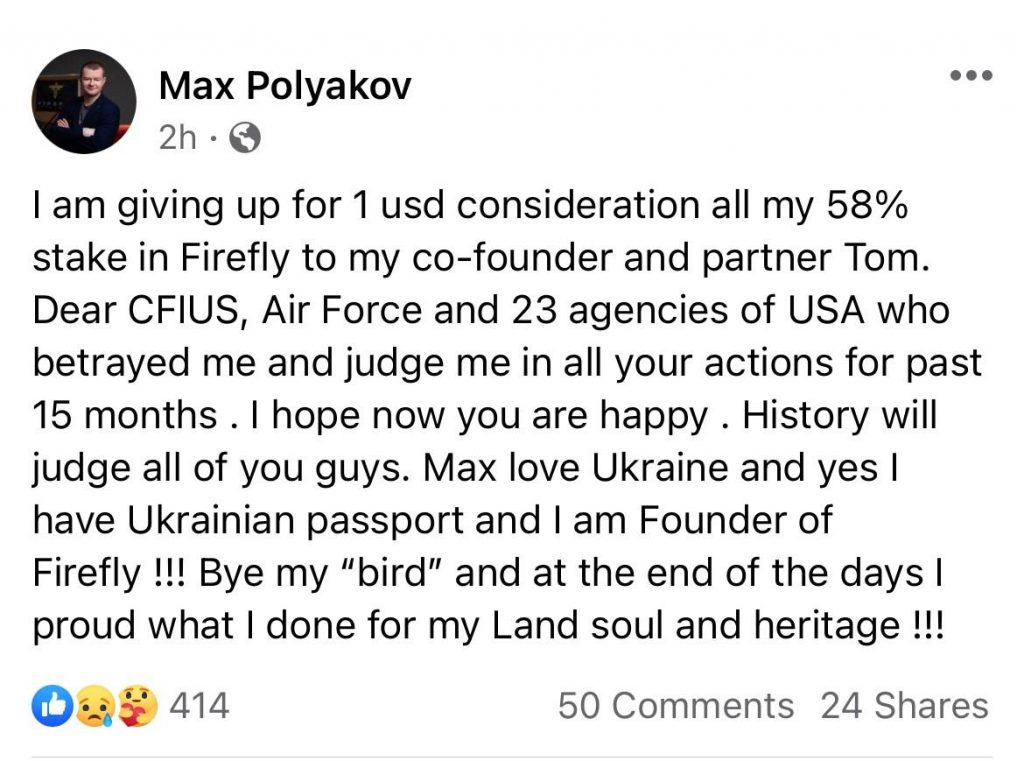

News
Firefly nears second orbital launch attempt as US forces Ukrainian founder to divest
While the rocket startup he is responsible for resurrecting is preparing for a second orbital launch attempt, a Ukrainian multimillionaire – an entrepreneur, businessman, and the founder of Firefly Aerospace – has once again been forced to take extreme actions by the US government.
Resurrected in 2017 after going bankrupt and ceasing operations the year prior, Firefly is a private launch provider based out of Austin, Texas and founded by Maxim Polyakov and former CEO Tom Markusic. Polyakov has supported the company since its second inception, privately funding the startup with over $200 million earned through success in Ukrainian tech industries. With those contributions, Polyakov was able to singlehandedly resurrect the startup from bankruptcy and continue the development of an even more ambitious Alpha launch vehicle.
For the last two years, though, Polyakov has been under scrutiny from US government officials, who’ve objected to Polyakov – a Ukrainian and UK citizen – having control over the company, with fears that the launch technology developed by the company could make its way back to Ukraine and poses a national security threat.
The update that's rolling out to the fleet makes full use of the front and rear steering travel to minimize turning circle. In this case a reduction of 1.6 feet just over the air— Wes (@wmorrill3) April 16, 2024
In late 2020, Polyakov quietly stepped down as chairman and withdrew from Firefly’s day-to-day operations in the hopes of killing the controversy and giving the startup a better chance at being awarded government contracts. Firefly’s board of directors includes many former U.S government officials, including Deborah Lee James, former secretary of the Air Force, and Robert Cardillo, former director of the National Geospatial Intelligence Agency.
However, officials were not satisfied with Polyakov simply stepping down from operations, indicating they want him to have less ownership in the company as well. In November 2021, just two months after Firefly’s inaugural flight test, Polyakov received a letter from the Committee on Foreign Investment in the U.S (CFIUS). This letter expressed these ongoing concerns and asked that he, along with his investment company, Noosphere Venture Partners, sell their stock in Firefly; which amounted to over 50% stake in the company. Because of this request, Firefly halted their operations at Vandenberg Air-force Base.
Before halting launch operations, Firefly claimed to be on track for another Alpha launch as early as January 2022. Firefly’s first launch on September 2nd, 2021 ended in failure around two minutes after liftoff due to a premature engine shutdown. Jason Mello, president of Firefly Space Transportation Services, stated in an interview that fixing the problem responsible for the failure was “fairly easy and straightforward.”
On February 16th, 2022 Polyakov revealed that the United States government had once again gone on the offensive, this time forcing him to fully and permanently cede any involvement in his company. He posted the following statement on Facebook:

Polyakov revealed that he chose to sell his 58% stake in the company to co-founder and CEO Tom Markusic for $1 USD – a selfless act given that selling his stake for nothing all but guarantees he will never recoup a cent of the several hundred million dollars he invested in Firefly.
Previously, Polyakov expressed how excited he was to turn Firefly into a massive aerospace company that both the United States and Ukraine could be proud of and benefit from. “During the Soviet era, Ukraine produced some of the world’s best rocket and engine technology, but much of those inventions have languished in recent years due to lack of investment. The hope was that Firefly could pair its best engineers from the U.S. and Ukraine together to make a fleet of large rockets capable of taking many satellites into orbit and, later on, missions to the moon. Polyakov wanted the U.S. to gain access to Ukrainian expertise, while also finding a way to boost the prospects of Ukrainian aerospace engineers, he has said.” (Bloomberg)
It is speculated that the US government’s sudden and extreme requests came because of concerns over the rising tensions caused by Russia’s increasingly unstable posturing and recurring threats of invasion. Even though Ukraine is friendly with the United States, concerns of conflict with Russia may have increased worries about what might happen to technology developed inside of the country. Ukraine, a sovereign nation, has been forced to increase security along its borders as fear of a Russian invasion grows.
Despite the recent legal and organizational setbacks and drama caused by the US government, Firefly has been doing extremely well from a technical standpoint. The company recently shared a video of the successful static fire testing of both stages of the second Alpha rocket, indicating that it could be ready for flight in the very near future. Even though Polyakov was forced to abandon his aerospace startup, it’s never been more clear that his investment not only saved Firefly but raised the company closer to success than it’s ever been before.

Elon Musk
GM CEO Mary Barra says she told Biden to give Tesla and Musk EV credit
“He was crediting me, and I said, ‘Actually, I think a lot of that credit goes to Elon and Tesla…You know me, Andrew. I don’t want to take credit for things.”

General Motors CEO Mary Barra said in a new interview on Wednesday that she told President Joe Biden to credit Tesla and its CEO, Elon Musk, for the widespread electric vehicle transition.
She said she told Biden this after the former President credited her and GM for leading EV efforts in the United States.
During an interview at the New York Times Dealbook Summit with Andrew Ross Sorkin, Barra said she told Biden that crediting her was essentially a mistake, and that Musk and Tesla should have been explicitly mentioned (via Business Insider):
“He was crediting me, and I said, ‘Actually, I think a lot of that credit goes to Elon and Tesla…You know me, Andrew. I don’t want to take credit for things.”
GM CEO Mary Barra said to Andrew Sorkin at the New York Times Dealbook Summit that she pulled President Biden aside and said Tesla CEO @elonmusk deserved the credit for EVs:
“He was crediting me, and I said, ‘Actually, I think a lot of that credit goes to Elon and Tesla,'” Barra… pic.twitter.com/OHBTG1QfbJ
— TESLARATI (@Teslarati) December 3, 2025
Back in 2021, President Biden visited GM’s “Factory Zero” plant in Detroit, which was the centerpiece of the company’s massive transition to EVs. The former President went on to discuss the EV industry, and claimed that GM and Barra were the true leaders who caused the change:
“In the auto industry, Detroit is leading the world in electric vehicles. You know how critical it is? Mary, I remember talking to you way back in January about the need for America to lead in electric vehicles. I can remember your dramatic announcement that by 2035, GM would be 100% electric. You changed the whole story, Mary. You did, Mary. You electrified the entire automotive industry. I’m serious. You led, and it matters.”
People were baffled by the President’s decision to highlight GM and Barra, and not Tesla and Musk, who truly started the transition to EVs. GM, Ford, and many other companies only followed in the footsteps of Tesla after it started to take market share from them.
Elon Musk and Tesla try to save legacy automakers from Déjà vu
Musk would eventually go on to talk about Biden’s words later on:
“They have so much power over the White House that they can exclude Tesla from an EV Summit. And, in case the first thing, in case that wasn’t enough, then you have President Biden with Mary Barra at a subsequent event, congratulating Mary for having led the EV revolution.”
In Q4 2021, which was shortly after Biden’s comments, Tesla delivered 300,000 EVs. GM delivered just 26.
News
Tesla Full Self-Driving shows confident navigation in heavy snow
So far, from what we’ve seen, snow has not been a huge issue for the most recent Full Self-Driving release. It seems to be acting confidently and handling even snow-covered roads with relative ease.

Tesla Full Self-Driving is getting its first taste of Winter weather for late 2025, as snow is starting to fall all across the United States.
The suite has been vastly improved after Tesla released v14 to many owners with capable hardware, and driving performance, along with overall behavior, has really been something to admire. This is by far the best version of FSD Tesla has ever released, and although there are a handful of regressions with each subsequent release, they are usually cleared up within a week or two.
Tesla is releasing a modified version of FSD v14 for Hardware 3 owners: here’s when
However, adverse weather conditions are something that Tesla will have to confront, as heavy rain, snow, and other interesting situations are bound to occur. In order for the vehicles to be fully autonomous, they will have to go through these scenarios safely and accurately.
One big issue I’ve had, especially in heavy rain, is that the camera vision might be obstructed, which will display messages that certain features’ performance might be degraded.
So far, from what we’ve seen, snow has not been a huge issue for the most recent Full Self-Driving release. It seems to be acting confidently and handling even snow-covered roads with relative ease:
FSD 14.1.4 snow storm Ontario Canada pic.twitter.com/jwK1dLYT0w
— Everything AI (@mrteslaspace) November 17, 2025
I found the steepest, unplowed hill in my area and tested the following:
• FSD 14.2.1 on summer tires
• FSD 14.2.1 on winter tires
• Manual drivingBut I think the most impressive part was how FSD went DOWN the hill. FSD in the snow is sublime $TSLA pic.twitter.com/YMcN7Br3PU
— Dillon Loomis (@DillonLoomis) December 2, 2025
Well.. I couldn’t let the boys have all the fun!
Threw the GoPro up and decided to FSD v14.2.1 in the snow. Roads were not compacted like the other day, a little slippery, but overall doable at lower speeds. Enjoy the video and holiday music 🎶
Liked:
Took turns super slow… pic.twitter.com/rIAIeh3Zu3— 🦋Diana🦋 (@99_Colorado) December 3, 2025
Moving into the winter months, it will be very interesting to see how FSD handles even more concerning conditions, especially with black ice, freezing rain and snow mix, and other things that happen during colder conditions.
We are excited to test it ourselves, but I am waiting for heavy snowfall to make it to Pennsylvania so I can truly push it to the limit.
News
Tesla hosts Rome Mayor for first Italian FSD Supervised road demo
The event marked the first time an Italian mayor tested the advanced driver-assistance system in person in Rome’s urban streets.

Tesla definitely seems to be actively engaging European officials on FSD’s capabilities, with the company hosting Rome Mayor Roberto Gualtieri and Mobility Assessor Eugenio Patanè for a hands-on road demonstration.
The event marked the first time an Italian mayor tested the advanced driver-assistance system in person in Rome’s urban streets. This comes amid Tesla’s push for FSD’s EU regulatory approvals in the coming year.
Rome officials experience FSD Supervised
Tesla conducted the demo using a Model 3 equipped with Full Self-Driving (Supervised), tackling typical Roman traffic including complex intersections, roundabouts, pedestrian crossings and mixed users like cars, bikes and scooters.
The system showcased AI-based assisted driving, prioritizing safety while maintaining flow. FSD also handled overtakes and lane decisions, though with constant driver supervision.
Investor Andrea Stroppa detailed the event on X, noting the system’s potential to reduce severe collision risks by up to seven times compared to traditional driving, based on Tesla’s data from billions of global fleet miles. The session highlighted FSD’s role as an assistance tool in its Supervised form, not a replacement, with the driver fully responsible at all times.
Path to European rollout
Tesla has logged over 1 million kilometers of testing across 17 European countries, including Italy, to refine FSD for local conditions. The fact that Rome officials personally tested FSD Supervised bodes well for the program’s approval, as it suggests that key individuals are closely watching Tesla’s efforts and innovations.
Assessor Patanè also highlighted the administration’s interest in technologies that boost road safety and urban travel quality, viewing them as aids for both private and public transport while respecting rules.
Replies on X urged involving Italy’s Transport Ministry to speed approvals, with one user noting, “Great idea to involve the mayor! It would be necessary to involve components of the Ministry of Transport and the government as soon as possible: it’s they who can accelerate the approval of FSD in Italy.”








